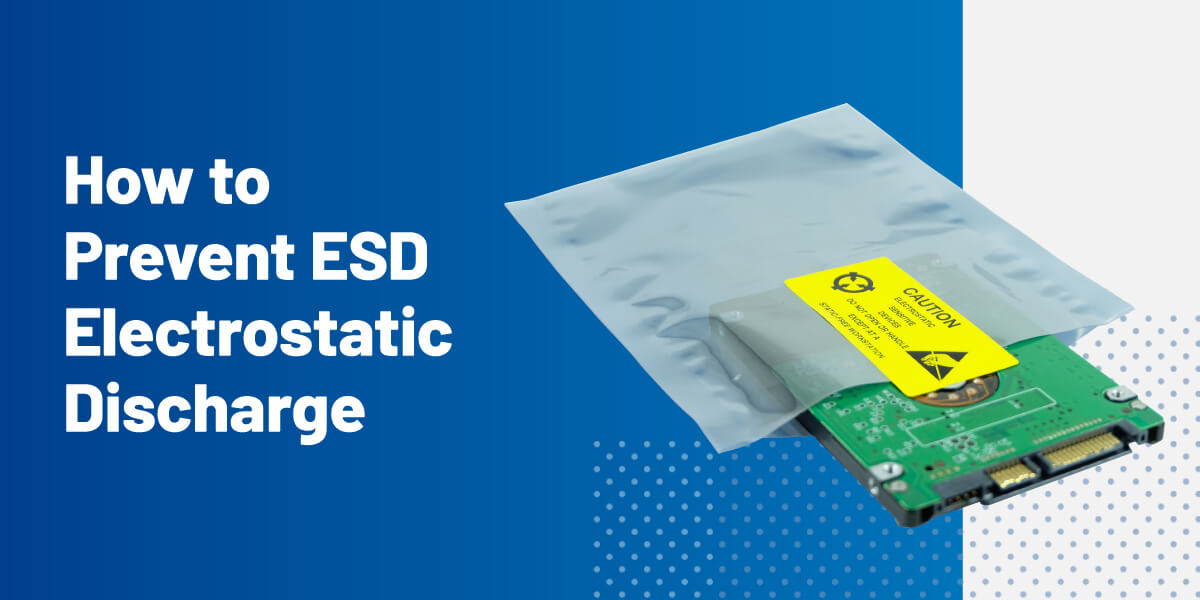Whether you manufacture electronic consumer goods or explosive powders for the military, your customers have one thing in common — they expect your products to arrive undamaged. That reality means you must safeguard your goods against threats like moisture and corrosion. With sensitive electronics, it also means protecting them from electrostatic discharge (ESD).
ESD can cause failure of electronics and extensive damage to medical devices, paper, plastics and more. In industrial applications, ESD can slow your production rate and quality, create safety concerns and introduce contaminants to your products. Protections from ESD are essential to deliver quality products to your customers.
What Is Electrostatic Discharge?
Electrostatic discharge is the emission of static electricity between two objects with differing charges and electron counts when they make contact. Common examples include the charge you experience when taking laundry from the dryer or walking across a carpeted floor and touching a doorknob. This phenomenon happens in nature during storms — lightning is ESD.
Why Is ESD Bad for Electronic Devices?
While small shocks and laundry-related ESD are rarely concerning, this discharge can harm electronic components and devices. Measurable static currents carry heat and can easily damage sensitive circuitry. More extreme voltages can also produce sparks, which could lead to a fire.
The charge transfer during ESD causes extremely high temperatures. When ESD is released into electronics, the heat itself can melt and vaporize the components, leading to failure. Electronics can experience two types of ESD damage at many points throughout their life cycle:
- Catastrophic damage: Some electronic devices that undergo ESD events may fail immediately. Heat from static discharge can cause junction failure, oxide breakdown and circuitry melting.
- Latent damage: Other electronics may experience a latent defect — the component is damaged but only partially degraded. The product will continue to operate but may malfunction in the future or have a shorter life span.
Besides electrical damage, ESD can cause other issues like coal dust, fuel vapor and explosion ignition in gas.
Both high- and low-voltage ESD can damage electronic devices. Even small amounts of voltage can cause damage, with some parts more vulnerable than others. For example, it takes less than 10 volts of charge to harm many of the more sophisticated circuits used today.
What Causes and Influences ESD?
ESD comes from a buildup of static electricity or electrostatic charge, not just electricity in general. This buildup happens when two different conductors rub together. One conductor assumes the positive charge, and the other becomes negatively charged. As a result, the former now has an electrostatic buildup. When it contacts another conductor, a static charge is transferred, and it releases that buildup as ESD. A dielectric failure or electrical short can also cause ESD.
In an industrial environment, people and equipment can cause ESD. Employees can generate static charges during work when walking, item handling and assembly, and other types of movement. Moving equipment like conveyors, assembly machines and trucks can also generate a static charge. ESD from people or equipment can be up to a few thousand volts.
Factors influencing ESD include environmental humidity and the material’s ability to store a charge. The higher the humidity in the air, the less static electricity can build since moisture naturally helps dissipate charges. However, electrostatic current can still build in high-humidity environments. A material’s chemistry also affects static electric discharge. Some compositions can retain higher positive charges and generate increased voltages.
How to Prevent ESD
Preventing ESD starts with understanding the environment where the device is manufactured, used and handled. Then, you can take steps to reduce or eliminate the chance ESD will occur.
You can safeguard your products and protect against ESD events with solutions like anti-static and static-shielding bags. Electrostatic discharge packaging works by creating a Faraday cage effect, a scientific phenomenon that shields items inside the bag by dispersing the electromagnetic radiation on the outside. The positive and negative particles from the materials repel and move to opposite sides of the conductor. The redistributed charges create an opposing electrical field, shielding the interior from exterior static charges.
The protection from the Faraday cage makes anti-static bags a common method to protect electronic devices from electrostatic charges. The conductive material and structural design of the package are key factors in Faraday cage protection.
Trust Edco Supply Corporation for Anti-Static Bags
Edco has been a leading source of anti-static and static-shielding bags since 1954. We use our decades of expertise to provide high-quality electrostatic packaging solutions to customers throughout Canada and the United States. Contact us for product guidance for your application, or request a quote today.



